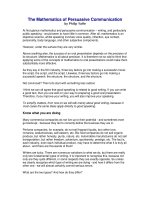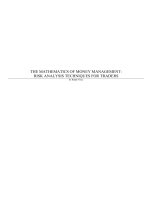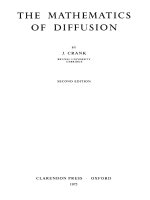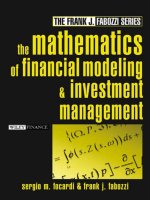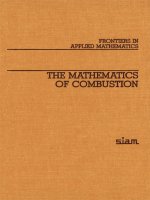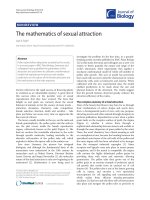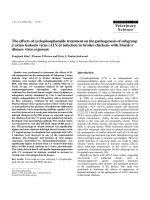the mathematics of diffusion (j. crank)
Bạn đang xem bản rút gọn của tài liệu. Xem và tải ngay bản đầy đủ của tài liệu tại đây (7 MB, 421 trang )
THE MATHEMATICS
OF DIFFUSION
BY
J.
CRANK
BRUNEL UNIVERSITY
UXBRIDGE
SECOND EDITION
CLARENDON PRESS OXFORD
1975
Oxford University Press, Ely House, London W.I
GLASGOW NEW YORK TORONTO MELBOURNE WELLINGTON
CAPE TOWN IBADAN NAIROBI DAR ES SALAAM LUSAKA ADDIS ABABA
DELHI BOMBAY CALCUTTA MADRAS KARACHI LAHORE DACCA
KUALA LUMPUR SINGAPORE HONG KONG TOKYO
ISBN 0 19 853344 6
OXFORD UNIVERSITY PRESS 1975
All rights reserved. No part of this publication may be reproduced,
stored in a retrieval system, or transmitted, in any form or by any means.
electronic, mechanical, photocopying, recording or otherwise, without
the prior permission of Oxford University Press
FIRST EDITION 1956
SECOND EDITION 1975
PRINTED IN GREAT BRITAIN
BY J. W. ARROWSMITH LTD., BRISTOL, ENGLAND
PREFACE TO SECOND EDITION
IN
preparing this second edition
I
have tried
to
incorporate
as
much
new
material
as
possible
but to
preserve
the
character
of the
original volume.
The book contains
a
collection
of
mathematical solutions
of
the differential
equations
of
diffusion
and
methods
of
obtaining them. They
are
discussed
against
a
background
of
some
of
the experimental
and
practical situations
to which they are relevant. Little mention
is
made
of
molecular mechanisms,
and
I
have made only fleeting excursions into
the
realms
of
irreversible
thermodynamics. These
I
hope
are
self-explanatory.
A
number
of
general
accounts
of the
subject
are
already available,
but
very
few
mathematical
solutions
of the
equations
of
non-equilibrium thermodynamics have been
obtained
for
practical systems.
During
the
last 15-20 years
the
widespread occurrence
of
concentration-
dependent diffusion
has
stimulated
the
development
of
new analytical
and
numerical solutions. The time-lag method
of
measuring diffusion coefficients
has also been intensively investigated
and
extended. Similarly,
a lot of
attention
has
been devoted
to
moving-boundary problems since
the
first
edition was published. These
and
other matters have now been included
by
extensive revision
of
several chapters. Also,
the
chapter dealing with
the
numerical solution
of
the diffusion equations has been completely rewritten
and brought
up to
date.
It
seems unbelievable now that most
of
the calcula-
tions
in the
first edition were carried
out on
desk calculating machines.
Two entirely new chapters have been added.
In
one are assembled some
of
the mathematical models
of
non-Fickian
or
anomalous diffusion occurring
mainly
in
solvent-polymer systems
in the
glassy state. The other attempts
a
systematic review
of
diffusion
in
heterogeneous media, both laminates
and
particulates.
A
succession
of
improved solutions are described
to
the problem
of diffusion
in a
medium
in
which
are
embedded discrete particles with
different diffusion properties.
I have resisted the temptation
to
lengthen appreciably the earlier chapters.
The enlarged edition
of
Carslaw
and
Jaeger's book Conduction
of
heat
in
solids contains
a
wealth
of
solutions
of
the heat-flow equations
for
constant
heat parameters. Many
of
them are directly applicable
to
diffusion problems,
though
it
seems that some non-mathematicians have difficulty
in
makitfg
the necessary conversions.
For
them
I
have included
a
brief 'translator's
guide'.
A few
new solutions have been added, however, some
of
them
in the
context
in
which they arose, that
is
the measurement
of
diffusion coefficients.
I should like
to
express
my
appreciation
to the
Vice Chancellor
and
Council
of
Brunei University
for so
readily agreeing
to my
application
for
extended leave without which
I
could not have undertaken the preparation
of
vi
PREFACE TO THE SECOND EDITION
a second edition. I am deeply grateful to my academic colleagues who shared
my administrative responsibilities and particularly to Professor Peter
Macdonald who so willingly and effectively assumed the role of Acting Head
of the School of Mathematical Studies.
I am most grateful to Mrs. Joyce Smith for all the help she gave me, not
least by typing the manuscript and checking the proofs. Mr. Alan Moyse
kept me well supplied with the seemingly innumerable books, journals, and
photostat copies which I requested.
I owe a great deal to friendly readers who have pointed out mistakes in the
first edition and made helpful suggestions for the second. In particular I
have benefited from discussions with my friend and former colleague, Dr.
Geoffrey Park. I had an invaluable introduction to the literature on which
Chapter 12 is based from Mr. W. M. Woodcock, who came to me for help
but, in fact, gave far more than he received. Finally, I have appreciated the
understanding help and guidance afforded me by members of staff of the
Clarendon Press.
Uxbridge J. C.
October 1973
ACKNOWLEDGEMENTS
I wish to acknowledge the permission of the authors or publishers of the following
journals or books to reproduce the figures and tables specified: Fig. 4.9, Barrer, R.
M. Trans. Faraday Soc; Fig. 10.8, Frensdorff, H. K. J. Poly. ScL; Fig. 11.1, Rogers,
C. E. 'Physics and Chemistry of the Organic Solid State'. J. Wiley & Sons Inc.; Fig.
11.2,
J. Poly. ScL; Fig. 12.1, Jefferson, T. B. Ind. & Eng. Chem.; Fig. 12.2, Tsao, G.
Ind. & Eng.
Chem.;
Fig. 12.3,
Cheng,
S. C. &
Vachon,
R. I. J. Heat & Mass Transfer;
Fig.
13.11,
/. Inst.
Maths.
Applies.;
Table 7.1, Lee, C. F. J. Inst.
Maths.
Applies.;
Table 7.6, Wilkins, J. E. /. Soc. Ind. Appl. Maths.; Table 7.7, Philip, J. R. Aust. J.
Phys.; Table 9.1, Wilkins, J. E. /. Soc. Ind. Appl. Maths.; and Table 10.2, Hansen,
C.
M. /. & E. C.
Fundamentals.
PREFACE
A MORE precise title for this book would be 'Mathematical solutions of
the diffusion equation', for it is with this aspect of the mathematics of
diffusion that the book is mainly concerned. It deals with the description of
diffusion processes in terms of solutions of the differential equation for
diffusion. Little mention is made of the alternative, but less well developed,
description in terms of what is commonly called 'the random walk', nor are
theories of the mechanism of diffusion in particular systems included.
The mathematical theory of diffusion is founded on that of heat conduction
and correspondingly the early part of this book has developed from 'Con-
duction of heat in solids' by Carslaw and Jaeger. These authors present many
solutions of the equation of heat conduction and some of them can be applied
to diffusion problems for which the diffusion coefficient is constant. I have
selected some of the solutions which seem most likely to be of interest in
diffusion and they have been evaluated numerically and presented in graphi-
cal form so as to be readily usable. Several problems in which diffusion is
complicated by the effects of an immobilizing reaction of some sort are also
included. Convenient ways of deriving the mathematical solutions are
described.
When we come to systems in which the diffusion coefficient is not constant
but variable, and for the most part this means concentration dependent, we
find that strictly formal mathematical solutions no longer exist. I have tried
to indicate the various methods by which numerical and graphical solutions
have been obtained, mostly within the last ten years, and to present, again in
graphical form, some solutions for various concentration-dependent
diffusion coefficients. As well as being useful in themselves these solutions
illustrate the characteristic features of a concentration-dependent system.
Consideration is also given to the closely allied problem of determining the
diffusion coefficient and its dependence on concentration from experimental
measurements. The diffusion coefficients measured by different types of
experiment are shown to be simply related. The final chapter deals with the
temperature changes which sometimes accompany diffusion.
In several instances I have thought it better to refer to an easily accessible
book or paper rather than to the first published account, which the reader
might find difficult to obtain. Ease of reference usually seemed of primary
importance, particularly with regard to mathematical solutions.
I should like to express my thanks to my friend and colleague, Mr. A. C.
Newns, who read the typescript and made many valuable comments and
suggestions, and also to Mrs. D. D. Whitmore, who did most of the calcula-
tions and helped to correct the proofs and compile the index. I am grateful
viii PREFACE
to Miss D. Eldridge who, by patient and skilful typing, transformed an almost
illegible manuscript into a very clear typescript for the printer. I should also
like to thank the following who readily gave permission to use material from
various publications: Professor R. M. Barrer, Mr. M. B. Coyle, Dr. P. V.
Danckwerts, Dr. L. D. Hall, Dr. P. S. H. Henry, Professor J. C. Jaeger, Dr.
G. S. Park, Dr. R. H. Stokes, Dr. C. Wagner, and the publishers of the
following journals, British Journal of Applied Physics, Journal of Chemical
Physics, Journal of Metals, Journal of Scientific Instruments, Philosophical
Magazine, Proceedings of the Physical Society, Transactions of the Faraday
Society. Finally, it is a pleasure to thank those members of the staff of the
Clarendon Press who have been concerned with the production of this book
for the kindness and consideration they have shown to me.
Maidenhead J. C.
December 1955
CONTENTS
1.
The diffusion equations 1
2.
Methods of solution when the diffusion coefficient is constant 11
3.
Infinite and sem-infinite media 28
4.
Diffusion in a plane sheet 44
5.
Diffusion in a cylinder 69
6. Diffusion in a sphere 89
7.
Concentration-dependent diffusion: methods of solution 104
8. Numerical methods 137
9. Some calculated results for variable diffusion coefficients 160
10.
The definition and measurement of diffusion coefficients 203
11.
Non-Fickian diffusion 254
12.
Diffusion in heterogeneous media 266
13.
Moving boundaries 286
14.
Diffusion and chemical reaction 326
15.
Simultaneous diffusion of heat and moisture 352
Tables 375
References 399
Author index 407
Subject index 411
THE DIFFUSION EQUATIONS
1.1. The diffusion process
DIFFUSION is the process by which matter is transported from one part of a
system to another as a result of random molecular motions. It is usually
illustrated by the classical experiment in which a tall cylindrical vessel has
its lower part filled with iodine solution, for example, and a column of clear
water is poured on top, carefully and slowly, so that no convection currents
are set up. At first the coloured part is separated from the clear by a sharp,
well-defined boundary. Later it is found that the upper part becomes coloured,
the colour getting fainter towards the top, while the lower part becomes cor-
respondingly less intensely coloured. After sufficient time the whole solution
appears uniformly coloured. There is evidently therefore a transfer of iodine
molecules from the lower to the upper part of the vessel taking place in the
absence of convection currents. The iodine is said to have diffused into the
water.
If it were possible to watch individual molecules of iodine, and this can be
done effectively by replacing them by particles small enough to share the
molecular motions but just large enough to be visible under the microscope,
it would be found that the motion of each molecule is a random one. In a
dilute solution each molecule of iodine behaves independently of the others,
which it seldom meets, and each is constantly undergoing collision with sol-
vent molecules, as a result of which collisions it moves sometimes towards a
region of higher, sometimes of lower, concentration, having no preferred
direction of motion towards one or the other. The motion of a single molecule
can be described in terms of the familiar 'random walk' picture, and whilst it is
possible to calculate the mean-square distance travelled in a given interval of
time it is not possible to say in what direction a given molecule will move in
that time.
This picture of random molecular motions, in which no molecule has a
preferred direction of motion, has to be reconciled with the fact that a transfer
of iodine molecules from the region of higher to that of lower concentration
is nevertheless observed. Consider any horizontal section in the solution and
two thin, equal, elements of volume one just below and one just above the
section. Though it is not possible to say which way any particular iodine
molecule will move in a given interval of time, it can be said that on the
average a definite fraction of the molecules in the lower element of volume
will cross the section from below, and the same fraction of molecules in the
2 THE DIFFUSION EQUATIONS
upper element will cross the section from above, in a given time. Thus, simply
because there are more iodine molecules in the lower element than in the
upper one, there is a net transfer from the lower to the upper side of the section
as a result of random molecular motions.
1.2. Basic hypothesis of mathematical theory
Transfer of heat by conduction is also due to random molecular motions,
and there is an obvious analogy between the two processes. This was recog-
nized by Fick (1855), who first put diffusion on a quantitative basis by
adopting the mathematical equation of heat conduction derived some years
earlier by Fourier (1822). The mathematical theory of diffusion in isotropic
substances is therefore based on the hypothesis that the rate of transfer of
diffusing substance through unit area of a section is proportional to the
concentration gradient measured normal to the section, i.e.
F = -DdC/dx, (1.1)
where F is the rate of transfer per unit area of section, C the concentration of
diffusing substance, x the space coordinate measured normal to the section,
and D is called the diffusion coefficient. In some cases, e.g. diffusion in dilute
solutions, D can reasonably be taken as constant, while in others, e.g. diffusion
in high polymers, it depends very markedly on concentration. If F, the
amount of material diffusing, and C, the concentration, are both expressed
in terms of the same unit of quantity, e.g. gram or gram molecules, then it is
clear from (1.1) that D is independent of this unit and has dimensions (length)
2
(time)"*,
e.g. cm
2
s~ *. The negative sign in eqn (1.1) arises because diffusion
occurs in the direction opposite to that of increasing concentration.
It must be emphasized that the statement expressed mathematically by
(1.1) is in general consistent only for an isotropic medium, whose structure
and diffusion properties in the neighbourhood of any point are the same
relative to all directions. Because of this symmetry, the flow of diffusing sub-
stance at any point is along the normal to the surface of constant concentration
through the point. As will be seen later in § 1.4 (p. 5), this need not be true
in an anisotropic medium for which the diffusion properties depend on the
direction in which they are measured.
1.3. Differential equation of diffusion
The fundamental differential equation of diffusion in an isotropic medium
is derived from eqn (1.1) as follows.
Consider an element of volume in the form of a rectangular parallelepiped
whose sides are parallel to the axes of coordinates and are of lengths
2 dx, 2 dy, 2 dz. Let the centre of the element be at P(x, y, z), where the
THE DIFFUSION EQUATIONS
concentration
of
diffusing substance
is C. Let
ABCD
and
A'B'C'D'
be the
faces perpendicular
to the
axis
of x as in Fig. 1.1.
Then
the
rate
at
which
diffusing substance enters
the
element through
the
face ABCD
in the
plane
x —
dx is
given
by
4dydz
'•-£*•>•
where
F
x
is the
rate
of
transfer through unit area
of
the corresponding plane
through
P.
Similarly
the
rate
of
loss
of
diffusing substance through
the
face
A'B'C'D'
is
given
by
4dydz
dx
dx
A"*
2dx A
FIG.
1.1. Element
of
volume.
B
,4djdz(/;+|£-dx)
The contribution
to the
rate
of
increase
of
diffusing substance
in the
element
from these
two
faces
is
thus equal
to
-Sdxdydz
8F,
dx'
Similarly from
the
other faces
we
obtain
—
8dxdydz
——
and
— I
dy
dz
But
the
rate
at
which
the
amount
of
diffusing substance
in the
element
increases
is
also given
by
dC
dt
'
and hence
we
have immediately
d£
dF, dFy dj^
dt
dx dy dz
(1.2)
4 THE DIFFUSION EQUATIONS
If the diffusion coefficient
is
constant,
F
x
,
F
y
,F
z
are given
by
(1.1), and (1.2)
becomes
dc ld
2
c
d
2
c d
2
c
D
+
dt
\dx
2
dy
2
dz
2
reducing simply
to
dt
dx
2
(1.3)
(1-4)
if diffusion
is
one-dimensional i.e.
if
there
is a
gradient
of
concentration only
along
the
x-axis. Expressions (1.1)
and
(1.4)
are
usually referred
to as
Fick's
first
and
second laws
of
diffusion, since they were first formulated
by
Fick
(1855)
by
direct analogy with the equations
of
heat conduction.
In many systems, e.g. the interdiffusion
of
metals
or
the diffusion
of
organic
vapours
in
high-polymer substances,
D
depends
on the
concentration
of
diffusing substance
C. In
this case, and also when
the
medium
is not
homo-
geneous
so
that
D
varies from point
to
point, eqn (1.2) becomes
dt
dx\ dxj dy
d
0£\
A
d
J d
dy J
dz
dz
where
D
may
be a
function
of
x,
y, z, and C.
If
D
depends
on the
time during which diffusion
has
been taking place
but
not on
any
of
the other variables,
i.e.
D
= f(t\
then
on
introducing
a
new time-scale
T
such that
the diffusion equation becomes
dC
_ d
2
C d
2
C d
2
C
which
is
the same
as
(1.3)
for a
constant diffusion coefficient equal
to
unity.
1.3.1. Diffusion
in a
cylinder and sphere
Other forms
of the
above equations follow
by
transformation
of co-
ordinates,
or by
considering elements
of
volume
of
different shape. Thus
by
putting
x
= r
cos
6,
y
= r
sin
8,
or
by
considering
an
element
of
volume
of a
cylinder
of
sides
dr, r
d0,
dz,
THE DIFFUSION EQUATIONS
we obtain the equation for diffusion in a cylinder,
8C
~dt
. 3C
88
D 8C
7~d~e
8_
~8~z
(1.7)
in terms of the cylindrical coordinates r, 0, z. The corresponding equation
for a sphere in terms of spherical polar coordinates r, 0, 0 is obtained by
writing
x = r sin 6 cos 0,
j;
= r sin 0 sin 0,
z = r cos 0,
or by considering an element of volume of a sphere of sides dr, r d#, r sin
It is
1
3C
sin
D d
2
C
sin
2
0
^ • d-8)
The simplified forms of (1.7) and (1.8) for purely radial diffusion, e.g. in a long
cylinder where end effects are negligible or in a spherically symmetrical
system, are given in Chapters 5 and 6, where some solutions of the differential
equations are to be found. All these diffusion equations can be expressed in
terms of the nomenclature of vector analysis as
dC
— = div (D grad C).
ct
1.4. Anisotropic media
Anisotropic media have different diffusion properties in different directions.
Some common examples are crystals, textile fibres, and polymer films in
which the molecules have a preferential direction of orientation. For such
media it is not always true, as was stated in § 1.2 (p. 2) for isotropic media,
that the direction of flow of diffusing substance at any point is normal to the
surface of constant concentration through the point. This means that (1.1)
must be replaced in general by the assumptions
dC
dC
8C
8C
Fz =
21
~8~x~
+
8C
21
~dy
8C
32
Ty
dC
(1.9)
6
THE
DIFFUSION EQUATIONS
so that F
x
, for example, depends not only on dC/dx but also on dC/dy and
dC/dz. The Ds have the significance that D
13
dC/dz, for example, is the con-
tribution to the rate of transfer in the x-direction due to the component of
concentration gradient in the z-direction. Substituting from (1.9) for the
Fs in (1.2) we obtain
dc
„ d
2
c ^ d
2
c
n
d
2
c ,
n
„
x
d
2
c
if the Ds are taken as constant. The extension to non-constant Ds is obvious
from (1.5). A transformation to rectangular coordinates £,
rj
9
C,
can be found
which reduces (1.10) to
—
-D— D— D— (111)
This is the same transformation as that by which the ellipsoid
+ (D
i2
+ D
21
)xy = constant
(1.12)
is reduced
to
D
1
£
2
+
D
2
ti
2
+D
3
C
2
=
constant.
(1.13)
The new axes may be called the principal axes of diffusion and D
x
, D
2
, D
3
the
principal diffusion coefficients. If we make the further transformation
.
(1.14)
where D may be chosen arbitrarily, (1.11) becomes
dC
(1.15)
This has the same form as eqn (1.3) for isotropic media, and hence certain
problems in anisotropic media can be reduced to corresponding problems in
isotropic media. Whether or not this can be done in a given case depends on
the boundary conditions. Thus it is possible when the medium is infinite, or
when it is bounded by planes perpendicular to the principal axes of diffusion
so that the boundary conditions are of the familiar form C = constant,
£, = 0, £ = /, t > 0, for example, and similarly for
Y\
and (. The problem of
diffusion into an anisotropic cylinder which has its axis along £ and is bounded
by planes perpendicular to £, reduces to the corresponding problem in an
isotropic cylinder provided D
2
= D
3
.
THE DIFFUSION EQUATIONS 7
Certain properties deduced by Carslaw and Jaeger (1959, p. 46) indicate
the physical significance of the ellipsoid and also of the principal axes
of diffusion. Thus it can be shown that the square of the radius vector of the
ellipsoid in any direction is inversely proportional to the diffusion coefficient
normal to the surfaces of constant concentration at points where their
normals are in that direction. Hence the diffusion coefficient D
n
at right angles
to surfaces whose normals have direction cosines /, m, n relative to the princi-
pal axes of diffusion is given by
D
n
= l
2
D
1
+m
2
D
2
+ n
2
D
3
. (1.16)
Carslaw and Jaeger further show that if there is symmetry about the planes
{ = 0 and t] = 0, then the general relationships (1.9) for the Fs reduce to
-F
4
= D, dC/d^ -F
n
= D
2
dC/dn, -F
c
= D
3
dC/dC. (1.17)
This simplification also occurs for other types of crystallographic symmetry.
It means that the flow through a surface perpendicular to a principal axis of
diffusion is proportional simply to the concentration gradient normal to the
surface as is the case for isotropic media.
1.4*1. Significance of measurements in anisotropic media
Since in the majority of experiments designed to measure a diffusion
coefficient the flow is arranged to be one-dimensional, it is worth while to
see how such measurements are affected by anisotropy. If the diffusion is
one-dimensional in the sense that a concentration gradient exists only along
the direction of x, it is clear from (1.10), since both C and dC/dx are everywhere
independent of y and z, that the diffusion is governed by the simple equation
8C d
2
C
and D
n
is the diffusion coefficient measured. If the direction of diffusion is
chosen to be that of a principal axis, then D
ll
is equal to one or other of the
principal diffusion coefficients D
l9
D
2
, or D
3
. Otherwise the coefficient
^u = Ai> related to D
l9
D
2
, D
3
, by (1.16) is measured. This would be
measured, for example, by an observation of the rate of flow through a plane
sheet of a crystal cut so that its normal has direction cosines (/, m, n) relative
to the principal axes of diffusion of the crystal. Similar remarks apply to a
high polymer sheet in which there is both uniplanar and undirectional
orientation, i.e., the molecules are arranged with their long axes lying mainly
parallel to the plane of the sheet and all parallel to one direction in that plane.
The principal axes of diffusion of such a sheet will be normal to the plane
sheet, and along and perpendicular to the preferred direction of orientation
in that plane. Even if a concentration gradient exists in one direction only,
8 THE DIFFUSION EQUATIONS
it is clear from (1.9) and (1.15) that the diffusion flow is not along this direction
unless it coincides with a principal axis of diffusion.
1.4.2.
Conversion of heat flow to diffusion solutions
Carslaw and Jaeger (1959) and other books contain a wealth of solutions
of the heat-conduction equation. There is general awareness among scientists
and engineers that the phenomena of heat flow and diffusion are basically the
same. Nevertheless, many non-mathematicians experience difficulty in
making the changes of notation needed to transcribe from one set of solutions
to the other. In this section we examine in detail the correspondence between
the physical parameters, the variables, and the equations and boundary
conditions which occur in heat-flow and diffusion problems. We take the
one-dimensional case with constant properties as an illustration.
(i) The equations. Diffusion theory is based on Fick's two equations (1.1)
and (1.4), where C is the concentration of diffusant expressed, say, in mass per
unit volume, and D is the diffusion coefficient. The two corresponding equa-
tions in heat flow are
F = -KdO/dx, (1.19)
ot \cp ox
where 0 is temperature, K is the heat conductivity, p is density, and c specific
heat, so that pc is the heat capacity per unit volume. The space coordinate is
x and t is time. In (1.19), F is the amount of heat flowing in the direction of x
increasing per unit time through unit area of a section which is normal to the
direction of x.
(ii) Variables and parameters. In order that the two sets of equations should
correspond we may identify concentration C with temperature 0, and take
D = Kin (1.1) and (1.19) and D = K/(cp) in (1.4) and (1.20). The two together
mean cp = 1. This is a consequence of our having identified C with 0. The
'diffusing substance' in heat flow is heat not temperature. The factor cp is
needed to convert temperature to the amount of heat per unit volume; but
concentration is, by definition, the amount of diffusing substance per unit
volume and so no conversion factor is needed, i.e. cp = 1. It is usual to write
K/(cp) = k, the heat diffusivity. All three of K, /c, cp appear in heat-flow
equations, and to convert to diffusion terms we take
D = K = k and cp = 1. (1.21)
(iii) Boundary conditions, (a) Prescribed surface temperature corresponds
to prescribed concentration just within the surface, say of a plane sheet.
If the surface is in contact with a vapour at pressure p, there is some relation
THE DIFFUSION EQUATIONS 9
between p and C such as C = Sp, where 5 is the solubility. There is no ana-
logue to S in heat flow.
(b) Prescribed heat flux corresponds to flux of diffusant and we have
- K dO/dx = F(t), in heat, (1.22a)
- D dC/dx = F(t\ in diffusion, (1.22b)
where F is in general a known function of time but may be constant.
(c) A heat-insulated surface corresponds to an impermeable surface and is
the special case of (1.22a, b) with F = 0, i.e.
dC/dx = d9/dx = 0.
(d) What is referred to as a 'radiation boundary condition' in heat flow
usually means that the heat flux across unit area of the surface is proportional
to the difference between the surface temperature 0
s
and the temperature 9
0
of the outside medium, i.e. is given by H(9
S
—
6
0
). But the rate of heat loss from
unit area of a surface is
—
K d6/dn in the direction of the normal n, measured
away from the surface, so that the boundary condition is
i.e.
where h = H/K. Sometimes this is referred to as Newton's law of cooling.
It corresponds to surface evaporation in diffusion, and we have
where a = h = H/D.
If the surface is perpendicular to the x-direction, as an example, dC/dn =
dC/dx if n is along the direction of x increasing but dC/dn = —dC/dx if
along x decreasing. Thus for a slab between x = 0 and x = 1 we have
dc/dx + <x(C
s
-C
0
) = 0, x = 1,
but
- dc/dx + a(C
s
- C
o
) = 0, x = 0.
(e) A perfect conductor of heat is always at a uniform temperature and so is
equivalent in this respect to a well-stirred fluid. Thus, a boundary condition
describing thermal contact with a perfect conductor also describes diffusion
of solute from a well-stirred solution or vapour. Conservation of heat from a
well-stirred fluid of fixed volume Kand uniform temperature 0
S
, a function of
time,
gives as a boundary condition on the surface x = 0 of a medium,
x > 0, in contact with the fluid
cpVdOJdt = KdO/dx
9
x = 0,
10 THE DIFFUSION EQUATIONS
where c, p have their usual meaning for the fluid. Correspondingly for diffusion
we have
VdCJdt = DdC/dx, x = 0.
In addition, 6
S
will be the temperature just within the surface but the two
concentrations may be related by some isotherm equation. Care is needed
with algebraic signs as in the previous section.
(f) The conservation principle applied at the interface between two media
of different properties leads immediately to boundary conditions
0
t
= 0
2
, K
x
dOJdx = K
2
d6
2
/dx
in heat flow and
C
x
= PC
2
+ g, D
x
dCJdx = D
2
dC
2
/dx,
in diffusion, where the suffices 1 and 2 denote the two media and P and Q
are constant.
(g) If heat is produced in a medium, e.g. as a result of an exothermic reac-
tion, at a rate A per unit volume, this must be added to the right side of eqn.
(1.20),
which can be written
d9 d
2
e
The diffusion equation (1.4) must be similarly modified if the diffusing sub-
stance is created or removed as diffusion proceeds. We identify A as the rate
of creation per unit volume and put cp = 1, K = D as usual.
(h) Problems in heat flow may involve moving boundaries on which phase
changes occur, accompanied by the absorption or liberation of latent heat.
In the first case, the relevant feature is that latent heat is removed instan-
taneously from the heat-conduction process, in which it takes no further part.
The diffusion counterpart is the immobilizing of diffusing molecules on
fixed sites or in holes. The velocity of the transformation boundary at X(t)
is related to the difference between the rate of heat arriving and leaving it by
conduction by a condition
-K
1
d6
1
/dx + K
2
d6
2
/dx = LpdX/dt,
where L is the latent heat per unit mass and p the density, assuming no volume
changes accompany the transformation. The condition in a diffusion problem
follows by writing 0 = C, D = K, p = 1 as usual, and L becomes the capacity
of the immobilizing sites in unit volume for trapped diffusing molecules.
Useful collections of mathematical solutions of the diffusion equations are
to be found in books by Barrer (1951), Jost (1952), and Jacobs (1967). Jacob's
solutions are of particular interest to biologists and biophysicists.
METHODS
OF
SOLUTION WHEN
THE
DIFFUSION COEFFICIENT
IS
CONSTANT
2.1.
Types
of
solution
GENERAL
solutions
of
the diffusion equation can
be
obtained
for a
variety
of
initial and boundary conditions provided the diffusion coefficient
is
constant.
Such
a
solution usually has one
of
two standard forms. Either
it is
comprised
of
a
series
of
error functions
or
related integrals,
in
wHich case
it is
most suit-
able
for
numerical evaluation
at
small times, i.e.
in
the early stages of diffusion,
or
it is in the
form
of a
trigonometrical series which converges most satis-
factorily
for
large values
of
time. When diffusion occurs
in a
cylinder
the
trigonometrical series
is
replaced
by a
series
of
Bessel functions.
Of
the three
methods
of
solution described
in
this chapter,
the
first
two
illustrate
the
physical significance
of the two
standard types
of
solution.
The
third,
em-
ploying
the
Laplace transform,
is
essentially
an
operator method
by
which
both types
of
solution may
be
obtained.
It is the
most powerful
of
the three,
particularly
for
more complicated problems. The methods are presented here
as simply
as
possible. The fuller treatments necessary
to
make
the
discussion
mathematically rigorous
are to be
found
in
works
on
heat conduction,
e.g.
Carslaw
and
Jaeger (1959).
2.2.
Method
of
reflection and superposition
2.2.1.
Plane source
It
is
easy
to see by
differentiation that
C = -texp(-x
2
/4Dt), (2.1)
where
A is an
arbitrary constant,
is a
solution
of
dC
_ d
2
C
dt
dx
2
'
which
is the
equation
for
diffusion
in one
dimension when
D is
constant.
The expression (2.1)
is
symmetrical with respect
to x = 0,
tends
to
zero
as x
approaches infinity positively
or
negatively
for t > 0, and for t = 0 it
vanishes everywhere except
at x = 0,
where
it
becomes infinite.
The
total
amount
of
substance
M
diffusing
in a
cylinder
of
infinite length
and
unit
12
METHODS OF SOLUTION WHEN THE
cross-section
is
given
by
M
/•oo
J
-
c
Cdx,
(2.3)
and
if the
concentration distribution
is
that
of
expression
(2.1) we see, on
writing
x
2
/4Dt
= £
2
, dx =
2{Dtf
df, (2.4)
that
/•a
M
- 2AD-
exp(-£
2
)d£
=
2A(nD)*.
(2.5)
Expression
(2.5)
shows that
the
amount
of
substance diffusing remains
constant
and
equal
to the
amount originally deposited
in the
plane
x = 0.
Thus,
on
substituting
for A
from (2.5)
in eqn
(2.1),
we
obtain
C
=
M
2{nDtf
exp(-x
2
/4Dt), (2.6)
and this
is
therefore
the
solution which describes
the
spreading
by
diffusion
of
an
amount
of
substance
M
deposited
at
time
t = 0 in the
plane
x = 0.
Fig.
2.1
shows typical distributions
at
three successive times.
l-25r
FIG.
2.1. Concentration-distance curves
for an
instantaneous plane source. Numbers
on
curves
are values
of Dr.
2.2.2. Reflection
at a
boundary
Expression
(2.6) can be
used
to
build
up
solutions
of
other problems
in
linear flow
by
introducing
the
concept
of
reflection
at a
boundary. Thus,
in
DIFFUSION COEFFICIENT IS CONSTANT 13
the problem just considered, half the diffusing substance moves
in
the direc-
tion
of
positive
x
and the other half along negative x.
If,
however, we have
a
semi-infinite cylinder extending over the region
x > 0
and with an imperme-
able boundary
at x =
0, all the diffusion occurs
in
the direction of positive
x.
We
can
consider
the
solution
for
negative
x to be
reflected
in the
plane
x
= 0
and superposed on the original distribution
in
the region
x > 0.
Since
the original solution was symmetrical about x
=
0 the concentration distribu-
tion
for
the semi-infinite cylinder
is
given
by
M
This procedure
of
reflection and superposition
is
mathematically sound,
for
reflection
at x = 0
means the adding
of
two solutions
of
the diffusion equa-
tion. Since this equation
is
linear the sum of the two solutions
is
itself a solu-
tion,
and we see
that (2.7) satisfies
the
condition that
the
total amount
of
diffusing substance remains constant
at
M. Furthermore, the condition
to be
satisfied
at
the impermeable boundary
is
dC/dx
= 0, x = 0, (2.8)
since this
is the
mathematical condition
for
zero flow across
a
boundary.
As dC/dx
is
zero
at x = 0 in
the original solution (2.6),
it is
clearly still zero
after reflection and superposition.
2.2.3.
Extended initial
distributions
So
far
we have considered only cases
in
which all the diffusing substance
is
concentrated initially
in a
plane. More frequently
in
practice, however,
the
initial distribution occupies
a
finite region and we have
an
initial state such
as that defined
by
C=C
0
,
x<0, C = 0, x>0, t =
0.
(2.9)
This
is the
initial distribution,
for
example, when
a
long column
of
clear
water rests
on a
long column
of
solution,
or
when two long metal bars
are
placed
in
contact
end to
end.
The
solution
to
such
a
problem
is
readily
deduced
by
considering
the
extended distribution
to be
composed
of an
infinite number
of
line sources
and by
superposing
the
corresponding
infinite number of elementary solutions. With reference to Fig. 2.2, consider the
diffusing substance
in an
element
of
width
^ to be a
line source
of
strength
C
o
S£. Then, from (2.6)
the
concentration
at
point
P,
distance
£
from
the
element,
at
time
t is
and
the
complete solution
due to the
initial distribution (2.9)
is
given
by
14
METHODS OF SOLUTION WHEN THE
summing over successive elements
81;,
i.e. by
=
%r
exp(-/7
2
)df/,
(2.10)
^
JxllJ(Dt)
Jx/2J(Dt)
where r\
=
\C
(
1
Si x
=
0
P x
FIG.
2.2. Extended initial distribution.
A standard mathematical function, of which extensive tables are available,
is the error function, usually written as erf z, where
erfz
=
-r|
exp(-f/
2
)df/.
This function has the properties
erf(-z)
=
-erfz, erf(O)
=
0, erf(oo)
= 1,
and hence, since
2
(2.11)
(2.12)
2 r
—
7T
2
J-
2
f
00
2 f
z
= — Qxp(-rj
2
)drj
-
— exp(->/
:
7C
2
J
o
7T
2
J
o
= 1
—
erf z
=
erfc
z,
(2.13)
where erfc
is
referred
to as
the error-function complement, the solution
(2.10) of the diffusion problem is usually written in the form
C(x, t)
=
iC
0
erfc
(2.14)
Convenient tables
of
the error function are those
of
the Works Project
Association (1941) and shorter tables are to be found, for example, in Milne-
Thomson and Comrie (1944). Table 2.1, taken from Carslaw and Jaeger
(1959),
is sufficient for many practical purposes. The form of the concentra-
tion distribution is shown in Fig. 2.3.
It
is clear from (2.14) that C
=
jC
0
at
x
=
0 for all
t
>
0.
The error function therefore enters into the solution of a diffusion problem
as
a
consequence
of
summing the effect
of a
series
of
line sources, each
yielding an exponential type of distribution.
DIFFUSION COEFFICIENT IS CONSTANT
15
10
0-8
0-6
G"
0-4
0-2
00
I I
-2-10 1 2
FIG.
2.3. Concentration-distance curve for an extended source of infinite extent.
In the same way, we can study the diffusion of a substance initially confined
in the region
—
h < x < + /i as in Fig. 2.4. Here the integration is from
x-h
to x + h instead of from x to oo as in (2.10), leading immediately to the
result
(2.15)
The concentration distribution at successive times is shown in Fig. 2.4. It is
clear that the system can be cut in half by a plane at x = 0 without affecting
l-U
0-8
0-6
0-4
0-2
on
-
0
V i
2
i
-3 -2
0
x/h
FIG.
2.4. Concentration-distance curves for an extended source of limited extent. Numbers on
curves are values of (Dt/h
2
)*.
16 METHODS OF SOLUTION WHEN THE
the distribution, which is symmetrical about x = 0. Therefore expression
(2.15) also gives the distribution in a semi-infinite system. Such a system is
realized in practice in the classical experiment in which a cylinder contains a
layer of solution having on top of it an infinitely-long column of water, initially
clear. In practice, this means that concentration changes do not reach the
top of the column during the time of the experiment.
2.2.4. Finite systems
If the column of water, referred to above, is of finite length /, the condition
that the concentration tends to zero as x approaches infinity is to be replaced
by the condition that there is no flow of diffusing substance through the top
surface, i.e.
dC/dx = 0, x = l (2.16)
We have seen that this condition is satisfied if the concentration curve is
considered to be reflected at the boundary and the reflected curve superposed
on the original one. In the finite system we are considering now, the curve
reflected at x = I is reflected again at x = 0, and then at x = /, and so on, the
result of each successive reflection being superposed on the original curve
(2.15).
Since the original solution is the sum of two error functions, the complete
expression for the concentration in the finite system is an infinite series of error
functions or error-function complements so that
c
=
2l + h-x
c
2l-
+f
Al-h-x
. 4/-x
f
A solution of this kind can be obtained for most problems in diffusion by use
of the Laplace transform, to be discussed in § 2.4 (p. 19), or otherwise. Such
solutions are most useful for calculating the concentration distribution in
the early stages of diffusion, for then the series converges rapidly and two or
three terms give sufficient accuracy for most practical purposes.
In all cases the successive terms in the series can be regarded as arising
from successive reflections at the boundaries. The nature of the reflection
depends on the condition to be satisfied. For the impermeable boundary
already considered a simple reflection ensures that dC/dx = 0 as required.
Another boundary condition which occurs frequently is of the type C = 0,
DIFFUSION COEFFICIENT IS CONSTANT 17
in which case it is necessary to change the sign of the concentration when
it is reflected at the boundary. A further example of the use of this method is
given by Jost (1952). For more complicated problems, however, the reflection
and superposition method soon becomes unwieldy and results are more
readily obtained by other methods.
2.3.
Method of separation of variables
A standard method of obtaining a solution of a partial differential equation
is to assume that the variables are separable. Thus we may attempt to find a
solution of (2.2) by putting
C =
X(x)T(t\
(2.18)
where X and T are functions of x and t respectively. Substitution in (2.2)
yields
which may be rewritten
1 AT Dd
2
X
T df X dx
2
'
(2.19)
so that we have on the left-hand side an expression depending on t only,
while the right-hand side depends on x only. Both sides therefore must
be equal to the same constant which, for the sake of the subsequent algebra,
is conveniently taken as
—
X
2
D. We have, therefore, two ordinary differential
equations
and
i
d
-^ l
2
(2
21)
Xdx
2
~ '
(
'
of which solutions are
T=e"
A2Dr
,
(2.22)
and
X = A sin Ax + B cos Xx, (2.23)
leading to a solution of (2.2) of the form
C = (A sin Xx + B cos Xx) exp (-
X
2
Dt),
(2.24)
18 METHODS
OF
SOLUTION WHEN
THE
where
A and B are
constants
of
integration. Since
(2.2) is a
linear equation,
the most general solution
is
obtained
by
summing solutions
of
type (2.24),
so that
we
have
co
C= Z (A
m
sinA
m
x + B
m
cosA
m
x)exp(-/^Dt\
(2.25)
where
A
m
, B
m
, and
X
m
are
determined
by the
initial
and
boundary conditions
for
any
particular problem. Thus
if we are
interested
in
diffusion
out of a
plane sheet
of
thickness
/,
through which
the
diffusing substance
is
initially
uniformly distributed
and the
surfaces
of
which
are
kept
at
zero concentration,
the conditions
are
C
= C
o
, 0 < x < /, t = 0
(2.26)
C
= 0, x = 0, x = /, t > 0.
(2.27)
The boundary conditions (2.27) demand that
B
m
= 0, X
m
= mn/l,
(2.28)
and hence
the
initial condition (2.26) becomes
CO
C
o
= Z
A
m sin
(mnx/l),
0 < x < /.
(2.29)
I
By multiplying both sides
of
(2.29)
by sin
(pnx/l)
and
integrating from
0 to /
using
the
relationships
.
pnx . mnx [0, m ^ p,
sin ——
sin
——
dx = <
(2.30)
/
/ l\U m =
p,
we find that terms
for
which
m is
even vanish,
and
A
m
=
4C
0
/mn,
m = 1, 3,
5,
The final solution
is
therefore
C
= —- V exp
{
—
D(2n+ I)
2
n
2
t/l
2
)
sin ,
(2.31)
n
n
=
0
2n+\ I
where
In +
1
has
been substituted
for m for
convenience
so
that
n
takes values
0,1,
2,
This trigonometrical-series type
of
solution converges satisfactorily
for moderate
and
large times,
and it is
then used
for
numerical evaluation
in
preference
to the
error-function type
of
solution discussed earlier
in § 2.2.4
(p.
16).
In (2.29)
the
initial distribution
is
expressed
as a sum of
sine functions.
This reveals
the
physical significance
of the
trigonometrical series
in
(2.31),
each term
of
which corresponds
to a
term
in the
Fourier series (2.29)
by
which
the
initial distribution
can be
represented.
